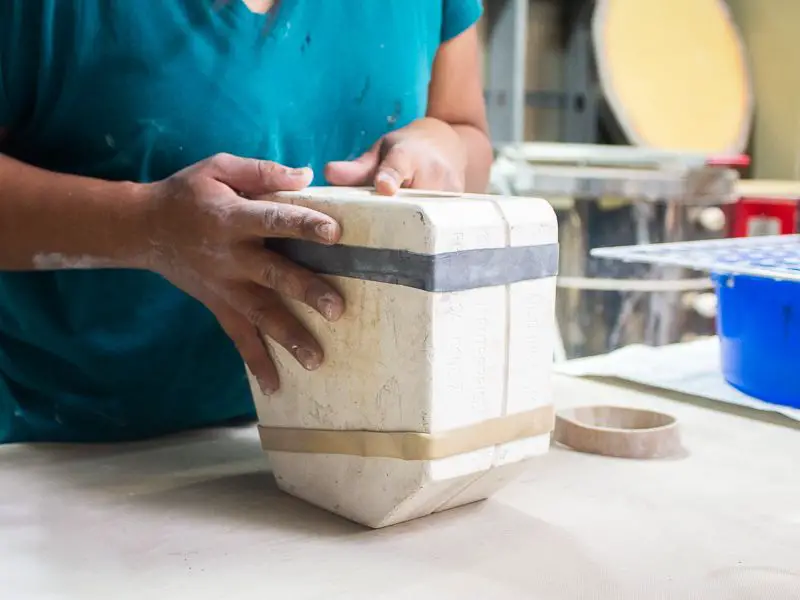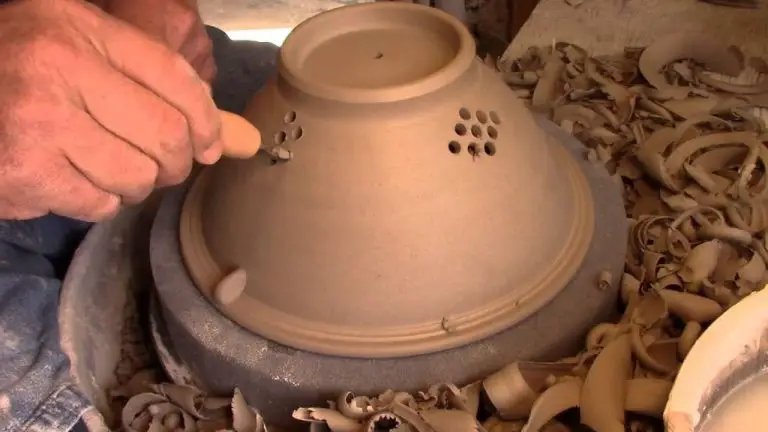How Long Do You Leave Slip In A Mold?
Slip casting is a ceramic forming process where a liquid clay body slip is poured into a plaster mold and allowed to solidify. As the slip contacts the mold, liquid is drawn out by capillary action into the plaster pores. The clay content is deposited on the mold walls, creating a hollow cast of the mold interior. With time, the cast becomes firm enough to be removed from the mold (Source 1).
The main goals of slip casting are to efficiently and accurately mass produce complex or detailed ceramic shapes. The plaster absorbs water from the slip against the mold walls, reproducing fine details. At the same time, excess liquid clay is drained away rather than built up in thick castings. This gives precise control over the final piece thickness (Source 2).
Time Considerations
There are several key factors that determine how long slip should be left in the plaster mold before removing the cast piece. The thickness of the piece being cast is one of the most important considerations. Thicker pieces will require more time for the slip to solidify and take shape. According to Whiteside, thicker pieces may need 12-24 hours or more before they are ready for removal, while thinner pieces may only need a few hours (https://www.elsevier.es/en-revista-boletin-sociedad-espanola-ceramica-vidrio-26-articulo-effect-preparation-variables-plaster-molds-S0366317517300596).
The size of the mold opening is also a key factor, as larger openings allow more surface area for water to evaporate from the slip. Small openings slow down the drying process. The specific recipe and makeup of the slip will impact drying time as well, based on variables like the deflocculant used, the solid-to-water ratio, and ingredients in the clay body (https://digitalfire.com/article/understanding+the+deflocculation+process+in+slip+casting).
Thick Pieces
For thicker pieces that require more wall thickness, the general guideline is to leave the slip in the mold for longer. According to You Will Be Slip Casting Ceramics With These 5 Easy Steps, for thicker pieces you may want to wait 15-25 minutes or more to allow the slip to thicken and build up thicker walls. The longer you leave the slip in the mold, the thicker the final piece will be.

Some potters recommend leaving thick pieces in the mold overnight or even for 24 hours for maximum thickness, as noted in this Reddit thread on slip casting times. The exact time will depend on the clay body, slip consistency, and desired wall thickness. Monitoring the slip over time and testing pieces periodically is recommended to dial in the ideal leave-in times for a particular mold and slip recipe.
Thin Pieces
For thinner pieces, less time is needed for the slip to absorb into the mold. Thinner pieces have less volume, so the slip will penetrate the mold faster. According to The Art of Slipmaking from Marjon Ceramics, “A fast flow time (thin slip) will probably lead to a slower setting time, whereas a thicker slip will have a shorter setting time.”
When working with thin pieces under 1/4″ thickness, a casting time of just 5-10 minutes may be sufficient if using a properly deflocculated casting slip. The thinner the piece, the less time needed. Carefully observe the slip penetrating the mold and remove the piece once the edges start to firm up and lose their sheen.
Be sure to properly deflocculate the casting slip according to the recipe. As noted in Understanding the Deflocculation Process in Slip Casting from Digitalfire, “It is only by putting energy into the slurry that you can thoroughly wet every particle and extract the best casting performance.” A well-deflocculated slip will flow smoothly into thin molds.
Porosity
Leaving slip in the mold for too long can cause excess porosity in slip cast pieces. As the water from the slip is pulled into the porous plaster mold through capillary action, it leaves behind the clay particles which build up on the mold surface to form the cast piece Understanding the Deflocculation Process in Slip Casting. If left in the mold too long, the cast layer continues to grow in thickness. The innermost layers, closest to the mold surface, dry and shrink first. The outer layers are still wet and continue to settle and condense. This differential shrinkage between the inner and outer layers can cause cracks and voids, creating excess porosity in the final piece Slip Casting – An Overview. To avoid excess porosity, it is important to limit the casting time to prevent the buildup of overly thick cast layers.
Drying
Once the slip cast piece is removed from the mold, it needs to fully dry before proceeding to the bisque firing stage. The drying process removes any excess water from the cast to ensure the clay body has reached the appropriate level of dryness. According to Digital Fire, slip cast pieces often do not even need to be covered during the drying process, as they have a low rate of warping or cracking. However, some guidelines can help ensure proper drying:
Set the cast pieces in a warm, dry area out of direct sunlight. Pieces can be placed on drying racks or boards to allow airflow all around the cast. Avoid drafty areas as this can cause uneven drying. The drying environment should have a consistent temperature between 70-90°F.
Allow thin pieces to dry for 12-24 hours, checking for any cracks. Thicker pieces will require a longer drying time, potentially up to a few days. Test the moisture content by feeling if there is any coldness or dampness. When fully dry, the pieces will feel warm to the touch.
Turn or rotate pieces periodically to prevent uneven drying on one side. Once fully dry, the pieces are ready for bisque firing before applying any surface decoration.
Recasting
Whether casting slip can be reused after draining from the mold is an important consideration from both an economic and environmental standpoint. According to the United States Patent Office[Source 1], recasting slip refers to slip that is drained from the mold and then reused in another casting. This allows the excess slip to be recycled rather than wasted. However, there are some limitations on reusing casting slip.
The viscosity and properties of the slip may change after an initial casting, which can affect the quality and integrity of subsequent castings. As explained by the United States Patent Office[Source 1], “After a polyester resin slip has been used in a casting operation, it breaks down and loses viscosity, thereby becoming unsuitable for employment in subsequent casting operations.” Too much of a viscosity change can prevent the slip from capturing the proper amount of detail from the mold.
Therefore, while draining and reusing slip is possible, adjustments and testing should be done to ensure the recasting slip maintains proper viscosity, curing, and handling properties. Fresh slip may need to be added to maintain quality. Recasting is most effective on thin or porous sculptures where draining occurs quickly, before substantial breakdown of the slip properties. For thicker or more intricate sculptures, fresh slip is generally recommended for optimal casting results.
[Source 1] https://patentimages.storage.googleapis.com/72/e5/60/c7f88fb5562f22/US3631131.pdf
Troubleshooting
If your cast pieces are undercast (not thick enough) or have bubbles/holes, the slip likely needs more time in the mold. Try increasing the casting time by 5-10 minutes to allow the slip to fully absorb into the plaster. According to the article Understanding the Deflocculation Process in Slip Casting, a thicker slip consistency will usually require more time to properly cast.
Overcasting (pieces too thick) can be remedied by decreasing the casting time by 5-10 minutes. The article Slip Troubleshooting recommends adjusting the casting time and slip consistency iteratively until the desired results are achieved. Smaller increments of 2-5 minutes may be needed for fine tuning.
Check for even drying of the plaster mold – uneven drying can cause variable thickness. Make sure to store the plaster mold in a consistent environment when not in use. Minor recipe adjustments may also help achieve more uniform casting.
Recipe Adjustments
The ingredients and ratios used in a slip casting recipe can significantly impact the time it takes for pieces to set in the mold. One of the most important factors is the water content of the slip. As explained on the Digitalfire website, “Highly flocculated slips form fractal, porous particle gel networks in the cast layer that allow water to pass through quickly, reducing casting time.” Cite This means slips with higher water content will drain more quickly from the mold.
Another key ingredient is the deflocculant used. Deflocculants help keep clay particles suspended evenly in the water. According to the Digitalfire article, “After the slip stands overnight and is mixed for a few minutes the next day, it will usually cast better.” Cite Letting the deflocculated slip rest allows the ingredients to fully disperse before casting.
Making adjustments to the recipe, such as increasing water content or letting the slip rest, can therefore help accelerate the slip casting process if shorter casting times are desired.
Summary
The key factors for determining the ideal slip casting time include the thickness and porosity of your pieces, the type of slip recipe and casting slip used, and the drying and climate conditions. Thicker and less porous pieces will require a longer casting time, while thinner and more porous pieces can typically be cast more quickly. Make adjustments based on your specific recipe, clay body, and environment. Test different time frames to find the optimum casting duration. Aim for pieces that retain their shape and can be removed cleanly from the mold without deformation. With practice, you’ll discover the ideal slip times for your projects.



